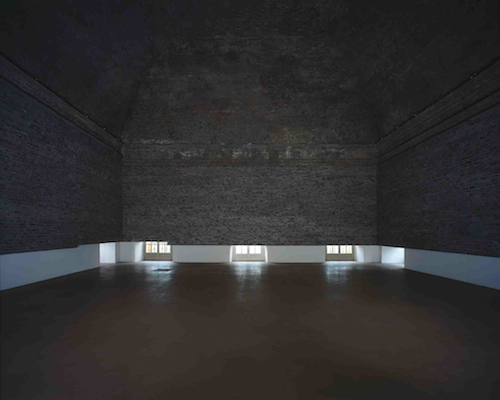100 Artists is a yearlong celebration of the 100 artists who have appeared to date in Art21′s award-winning film series Art in the Twenty-First Century. Throughout 2013, we are dedicating two to three days to each artist on our social media platforms—Twitter, Facebook, Tumblr, and here on the Art21 Blog. Our current featured artist is Doris Salcedo.

Doris Salcedo, “Abyss,” 2005. Brick, cement, steel and epoxyc resin installation. T1 Triennial of Contemporary Art, Castello di Rivoli, Torino. 173 1/2 x 545 1/2 x 639 1/4 in. Courtesy Alexander and Bonin, New York.
Today, Art21 released a previously unpublished interview with Doris Salcedo. Her words are powerful and sometimes chilling as she speaks of war, displacement, and imprisonment—realities that not only inform her work but are, as she sees them, her very material. Here’s an excerpt:
Art21: I’m curious how early on your political sensitivity was formed and when you connected that to the notion of being an artist. Looking back, when do you think you started to connect these things?
Doris Salcedo: I always wanted to be an artist. I cannot name a date when that came to me; it has always been there. Living in Colombia, in a country at war, means that war does not give you the possibility of distance. War engulfs reality completely. In some cases, people can be killed or wounded at war, but in most cases war just distorts your life. It throws a shadow over your entire life. War creates a totality and you are embedded in it. It’s like being engulfed in a reality. Political events are part of everyday life here, so art and politics came to me as a natural thing, something that has been very much present in my life from the start.
Art21: Explain a little bit more about war. I suspect for people living in the United States, they think about war as being something where two countries are fighting each other, and war here in Colombia it has a slightly different aspect.
Salcedo: I think war everywhere has a different aspect now, because I don’t think war is waged between two nations any longer, or not the main war. I think war is waged at different levels. And those levels that are subtler are the ones that really destroy the life of a big section of the population. I believe war is the main event of our time. War is what defines our lives. And it creates its own laws. War forces us to generate some ethical codes in which we exclude a whole part of the population; once they do not fit into in our ethical code, then we can attack them and destroy them because they are not “human.” So it’s a tool to expel people from humankind. I think that’s the main event, and that’s why it worries me so much. You see that there are civil wars going on everywhere on a daily basis. You are reading about these events and these events are really shaping the way in which we live. That’s what I’m trying to show in my work—that war is part of or our everyday life.
Continue reading Doris Salcedo: Variations on Brutality
______
Salcedo was featured in Season 5 of Art in the Twenty-First Century. Watch her segment at Art21.org.



